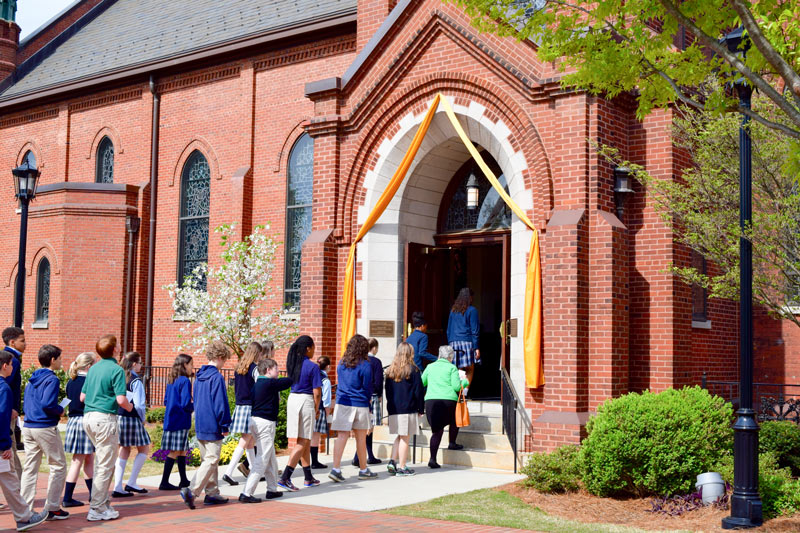
ST. PAUL, Minn.—For years, Annie Hinnenkamp of St. John the Baptist in New Brighton wanted to walk the Camino de Santiago de Compostela.
The 26-year-old finally got the chance in June 2018, walking 513 miles on the famous pilgrimage route through northern Spain with one of her four sisters and two of her four brothers, through rain and cold, sun and warmth, taking in sweeping vistas of ocean and tight confines of forest, small towns and many fellow travelers.
“It was a journey physically, spiritually, emotionally,” she said in an email interview this March with The Catholic Spirit, newspaper of the Archdiocese of St. Paul and Minneapolis. “I learned that the body can go much farther than you ever thought possible. I learned that the struggle in the journey makes the reward at the end worth something greater than if it were easy. I also learned how incredibly human I am.”
Hinnenkamp, an athletic trainer at Bethel University in St. Paul and a professor in that university’s human kinetics and health sciences department, also was reminded that God does not manifest himself at a beck and call.
“I was expecting to see God in so many ways, especially with the fact that he ordained all of us (she and her siblings) to go at the same time,” she said. “I should know by now that God doesn’t work that way in my life. … The Lord simply challenges me to see past my expectations, to break through my longing for his presence and realize that he thirsts for me even more.”
She experienced that on the Camino, the trail taken by millions of people through the centuries to the Cathedral de Santiago de Compostela, the reputed burial place of St. James the Apostle. The pilgrimage has inspired numerous books, documentaries and movies, including the 2010 film “The Way,” starring Martin Sheen and his son Emilio Esteves.
People can take a number of different trails. Hinnenkamp and her siblings walked from San Sebastian in northeast Spain to Santiago de Compostela in the northwest.
For Hinnenkamp, it was a challenge and a blessing.
She was ill with stomach problems most of the trip, along with her sister Rachael, a junior at the University of Mary in Bismarck, North Dakota. Rachael also was recovering from a four-year bout with Lyme disease, and with the exertion she experienced relapses of exhaustion, migraine headaches and nausea.
Their brother Tommy, a freshman at the University of Nebraska-Lincoln, fought through some significant knee pain. For their brother Billy, a senior at the University of Wisconsin-Eau Claire, the worst physical ailment was a sore throat, Hinnenkamp said.
Hinnenkamp said she broke down in tears several times, not feeling well, unable to eat much for about two weeks of the monthlong trek and feeling God’s absence.
But she found God in unexpected ways. One big way was through her prayers for others in petitions that she had solicited on Facebook and Instagram and wrote in the back of her journal. She trusted through her prayer that God was quietly working, regardless of how she felt.
“Each day I would pray for a new group of people, take a picture of their names on the walk, and post it online so they would know they were being prayed for. This did refocus me,” she said.
“It gave purpose to the walk, to the suffering, something to offer it up for and a reason to embrace the cross presented to me. The Lord didn’t feel any closer, but I knew he was at a good work. Nothing was a surprise to him, and that gave me comfort.”
After missing Mass during the journey because the liturgy wasn’t being offered near places they stayed or it was being held at a time they could not attend, she finally got to a Mass the day after they walked into Santiago de Compostela, on the feast of St. James, which is July 25. Her siblings were napping. But a long line for an earlier Mass had become a five-minute wait to get inside, and the liturgy was just getting underway.
After weeks without holy Communion, Hinnenkamp, who also has celiac disease, was first in line to receive the consecrated wine.
It was a simple but profound moment, as memories flooded over her from the trip. With hindsight, she realized the Lord had been present at moments she had not recognized, Hinnenkamp said.
Those included being able to use her medical background to help people as they sought advice for treating blisters, rashes, minor cuts and knee pain. And the evening a deaf woman from Denmark entered a room, and Hinnenkamp and Billy were able to communicate with the American Sign Language each had learned years earlier — and which the woman had learned when she taught at a school for the deaf in Seattle.
“Little moments I recalled when he (God) was there, and I didn’t know it,” she said.
Other parts of the trip brought more immediate joy, Hinnenkamp said. She loved being with her brothers and sister. She enjoyed the food — often salad, wine and water, a main course and dessert. And the “albergues” were fun, much like hostels, with bunkbeds, a community space and small kitchen, she said.
One particularly memorable evening involved fixing a meal with a woman from Arizona and a man from France and offering it to a group that grew to at least 11 people around the table, including one person from Denmark, two more from France, one from Spain and one from the Netherlands.
“How can people from such different backgrounds, languages, ages, reasons for walking, get along as if they had been family?” Hinnenkamp asked. “Truly a beautiful experience.”
With all the fun and despite the difficulties — or, perhaps in part, because of them — Hinnenkamp said she would recommend the pilgrimage to anyone who feels the call to make it.
“If he (God) is placing a desire to walk the Camino, all 35 days of it or just a week, then go — walk the Camino!” she said. “But if not, he is still calling you to a journey of your own.”
“Pay attention. Look at all the details. God is there,” she said. “And he sees you, and he loves you.”
By Joe Ruff/Catholic News Service: Ruff is news editor of The Catholic Spirit, newspaper of the Archdiocese of St. Paul and Minneapolis.



